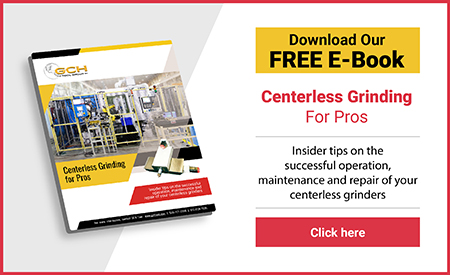How to Lower Operational Costs and Boost Productivity with Centerless Grinders
Centerless grinders are popular in many industries because they can remove material from the workpiece’s outer diameter without the support center. It is a good method for achieving accuracy in cylindrical metal pieces. Do you want to know how to reduce the cost of running your centerless grinding machine and boost its productivity? Continue reading to learn more!
How to Reduce the Operational Costs of Centerless Grinders
These three techniques have been shown to significantly reduce the expense of using a centerless grinder.
Choose the Appropriate Wheel
Before deciding on a wheel to use for your centerless grinder, you need to give a lot of thought to a number of factors. Among these are the material that will be ground and the hardness of that material, the required finish and the amount of stock removal, the contact area, the speed of the wheel and the grinding pressure.
Select the Right Coolant and Install It Correctly
Coolant serves several purposes: One, it keeps the temperature stable; two, it functions as a lubricant by reducing friction between the wheel and the workpiece; and three, it keeps the work blade and guides lubricated.
To guarantee that your coolant serves these functions, you should select the best one for your budget.
Each coolant type has advantages and disadvantages, and the choice will be determined by the grinder and the application. Oil is the most preferred coolant, and high-performance, ester-based grinding oil is highly recommended. However, oil is not always feasible due to its messy nature. In some applications, water-soluble and synthetic coolants may be necessary.
Although synthetic or semi-synthetic coolants are less expensive, they may not provide the same level of lubricity as pure oil. The quality of the coolant also has a significant impact on its longevity, which minimizes its cost.
Without adequate distribution, even the best coolant won’t be able to do its job. For efficient and cost-effective production, ensure the coolant reaches both the wheel and the centerless grinder parts. Not doing so could cause premature wheel wear and damage to other components of the centerless grinding machine.
Track Your Inbound Stock Removals
Inconsistent removal of stock can also affect wheel dress intervals, which can lead to premature wear on your centerless grinder wheel.
How to Make Your Centerless Grinder More Productive
Now that you have learned three tried-and-true ways to lower the cost of operating your centerless grinder, let’s move on to how to get the best out of it.
Performing Preventive Maintenance
Maintaining a regular routine for preventative maintenance is one of the best ways to make your centerless grinder more productive. There are numerous high-wear centerless grinding machine parts, and appropriate maintenance will not only assist you in identifying these wear areas but will also assist you in providing the essential lubrication and preventive care.
If you ignore the need for preventive maintenance, be prepared for an unexpected failure of your centerless grinder. Preventive maintenance is easy. Some tasks can be done at the end of each shift, while others must be done only once a year.
An electronic evaluation of the spindles, which can detect conditions that cause spindle failure, replacing any worn-out components on your grinder, conducting a comprehensive lubrication system inspection and checking for signs of loose spindle belts at least twice a year are all part of proper preventive maintenance.
Regular Cleaning
As simple as it appears, this is one of the best techniques to maximize productivity. Swarf is produced every time machine coolant goes through the machine. This implies that every time the operator turns off the machine, the coolant discharges and the remaining swarf will harden. The same thing will happen the next day, and the cycle will continue, causing it to accumulate, especially in places where it shouldn’t.
Cleaning up debris may appear simple, but it causes a decrease in production or waste when the grinder is reused. Furthermore, when swarf enters the sealing parts and penetrates where it should not, it will result in a bigger problem, such as increased bearing wear or downtime.
To make your centerless grinder more productive, remove all of the swarf that gathered while grinding to avoid swarf abrasion or limiting the lifespan of the grinding machine’s key parts.
Design a cleaning routine for the wheel dresser, regulating wheel dresser, power unit, panel, infeed slide stack and grinding wheel head, and inspect for oil leaks before lubricating every moving component. Not only will this prevent greater problems, but it will also make the grinding machine look cleaner and provide a more comfortable working environment.
Adding Automation to Grinders
Automating certain functions of a centerless grinder machine, such as removing the need for the operator to manually load the grinder machine or conveyor, is one technique to boost the output of the machine. Automatic loading and unloading minimizes operators’ workload and may even make it possible for them to run more machines, which will definitely assist them in meeting their production targets.
Also Read: The GCH Tool Advantage: Delivering High-Performance Centerless Grinder Parts
Contact GCH Tool Group for High-Quality Centerless Grinder Parts, Components and Repair Services
Contact GCH Tool Group if you need a specialist to help you with your centerless grinder or if you need new grinder components. We also have a free e-book on our site that details the best practices for centerless grinding.

